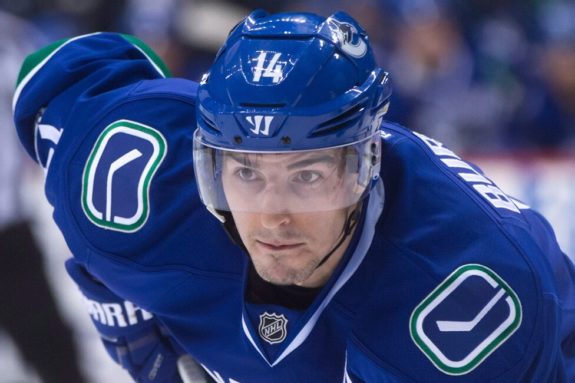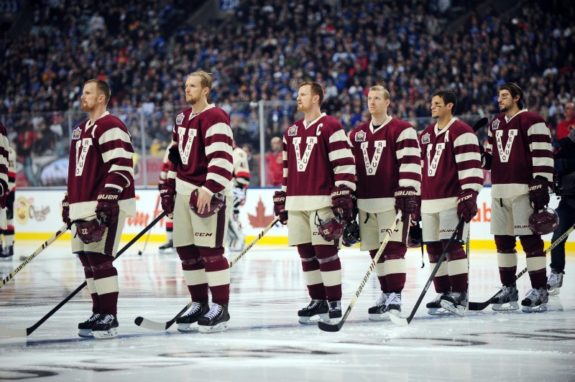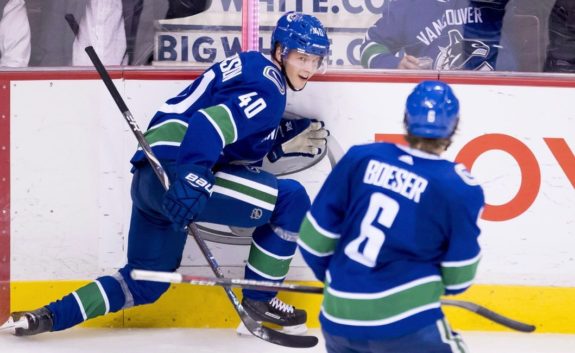In one month, a new decade will begin, starting with 2020. That year almost sounds fake. Fake like the move Bo Horvat used to beat Braden Holtby in the seventh round of the shootout on Nov. 23 against the Washington Capitals. However, the looming decade is not fake but a reality. Therefore, it is appropriate to revisit the history of the past decade for the Vancouver Canucks. A 10-year span that included the pinnacle of the team’s history as well as some very dark times.
Early Dominance from the Sedins
The Canucks entered the 2010s with a strong cup-contending team littered with numerous all-stars in their prime. In June 2010, Henrik Sedin captured the franchise’s first Hart Memorial Trophy, awarded to the Most Valuable Player of the league as decided on by the Professional Hockey Writers’ Association. However, this was not the only hardware Henrik won in the NHL awards ceremony in June 2010.
Flashback to three months prior, to the Canucks’ last game of the season against the Calgary Flames. Perennial multi-award contender, Alex Ovechkin was a mere three points behind the league leader, Henrik Sedin, with both the Canucks and Ovechkin’s Washington Capitals playing their last games of the season.

While Ovechkin remained pointless in his game against the Boston Bruins, Henrik recorded four assists that night securing Vancouver’s first-ever Art Ross Trophy – given to the player who leads the NHL in points. Arguably, the highlight of the decade for Vancouver occurred during this game when Henrik connected with brother Daniel, who scored between his legs to complete a hat trick, foreshadowing of what to expect for the next season.
Dramatic Cup Run
The 2010-11 season was the best season in the Vancouver club’s half-century existence. The Canucks finished first in the league standings and captured their first of two consecutive Presidents’ Trophies.
They scored the most goals and allowed the fewest goals. They had the best power play and an elite penalty kill. The league’s top scorer was Daniel Sedin, with brother Henrik not too far behind. The regular season set the stage for a playoff run of a lifetime.
It is difficult to choose one supreme highlight for the playoff run of 2010. Ryan Kesler’s domination of the Nashville Predators, Maxim Lapierre and Raffi Torres’ underrated game clinchers in the Western Conference Final, and Kevin Bieksa’s series-winning goal assisted from the stanchion were all so dramatic they could have been written by the Game of Thrones writers. However, much like Game of Thrones, the Canucks could not close out the final series properly.
Ultimately, the main highlight of that playoff run was Alexandre Burrows’ series-winning goal versus the Chicago Blackhawks or as John Shorthouse likes to say when the Canucks “slayed the dragon”.

If it were not for Burrows’ goal, none of the aforementioned memories would have occurred. The Chicago Blackhawks had been the team that eliminated the Canucks from the playoffs in the previous two years.
To make matters worse, the heavily-favoured Canucks had blown a commanding 3-0 series lead and one-goal lead with under two minutes remaining in regulation.
All hockey fans hated the Canucks that year and Burrows’ was their most antagonizing player. Not surprisingly, he is one of the most beloved players to Canuck fans as he is the true definition of starting from the bottom, working his way up the ranks from the ECHL. (from ‘Alex Burrows was the unlikeliest success story in Canucks history,’ Vancouver Courier, 10/10/2017)
Hence, this goal unified Canucks fans together on a mission to leave the doubters miserable. Burrows intercepted a Chicago clearing attempt and beat goaltender, Corey Crawford. The series-clinching overtime goal gave the Canucks momentum that would carry them to Game 7 of the Stanley Cup Final.
That is an event Canucks supporters will be forever thankful for.
Fall from Supremacy
After the heartbreaking loss to the Boston Bruins in the 2011 Stanley Cup Final, the Canucks continued their trend of regular-season excellence and playoff disappointment for several seasons in an attempt to postpone a full-blown rebuild.
Defeating the Bruins in the Stanley Cup rematch in the following season remains one of the top games of the decade. Who could forget that howitzer from Cody Hodgson to seal the game against their former arch-rivals? Although, they were only delaying the inevitable. Nonetheless, during these dark times, there was no lack of bizarre and dramatic moments.
Head coach John Tortorella kept it interesting while Vancouver kept on losing. He once tried to fight an entire team in their locker room by himself. It is surprising that advanced analytics have not started tracking that as an official stat yet. Tortorella also put an end to the lingering goaltending controversy in Vancouver.
He chose to start the young and fresh backup, Eddie Lack, over disgruntled starter, Roberto Luongo, for Vancouver’s first-ever Heritage Classic game. The goalie controversy culminated in Luongo being traded to the Florida Panthers two days later. (from ‘Luongo traded to Florida for Jacob Markstrom, Shawn Matthias,’ The Province, 03/04/2014)
Although the events that occurred were ugly, at least Canuck fans were blessed with these jerseys from the Heritage Classic that were the opposite of ugly (disregard the cream pants).

The Worst of Times
The bottom of the darkest hole for this decade arrived in 2016-17 when the Canucks finished with a measly 69 points, poor enough for second last place in the league. This was their worst full-season point total since the 1998-99 season.
In 2016-17, Vancouver only had four more wins in 82 games than they had in the shortened lockout season of 48 games in 2012-13. To make matters worse, the Canucks were so bad they could not win the draft lottery, jokingly, as the lottery is completely based off luck.
Bright Future Moving Forward
Losing the lottery turned out to be a blessing in disguise as Vancouver drafted their franchise centerman in Elias Pettersson at fifth overall that year. The Calder Trophy recipient already ranks third amongst Canuck players in points per game only behind legends Pavel Bure and Alexander Mogilny.
Drafting Pettersson was the biggest draft day success story in team history since drafting the Sedins in the in the late 1990s. Pettersson would play another year in Sweden before playing for Vancouver.
During that season is when fellow budding star, Brock Boeser, put the league on notice that the Canucks’ future was brightening.

Boeser seized the 2018 NHL All-Star Game MVP Award and was a bright spot for the rebuilding team. The race for the Calder Trophy with eventual winner, Matthew Barzal, made for an exciting storyline for the majority of that season. A new era had begun in Vancouver as they finally had young talent.
While the young phenoms took the reins, the Canucks paid respect to their legends of the past. Markus Naslund and Pavel Bure were honoured with jersey retirements while Orland Kurtenbach, Kirk McLean, Tomas Gradin, Harold Snepsts, Pat Quinn and Mattias Ohlund were inducted into the ring of honour with dragon-slayer, Burrows, to follow before the current year’s end.
Henrik and Daniel Sedin had a legendary closing to their legendary careers. Henrik passes to Daniel for a highlight-reel goal during the last home game of the year and also their last career game.
Sound familiar? It sounds like something you read 800 words ago. Number 22 and 33 capitalized at 2:33 into overtime. Eerily perfect. Big thanks to the aliens/hockey gods that made that fairy tale ending come true.
No Canuck will be able to wear those numbers ever again after this decade ends. The twins’ jersey retirement will be an early highlight for the beginning of the next decade. Hopefully, the first highlight of many to come.